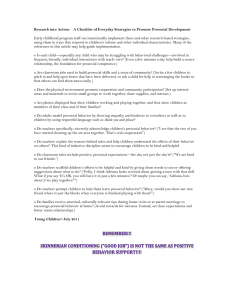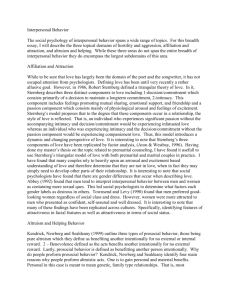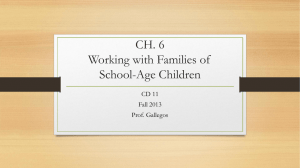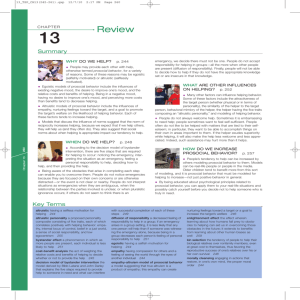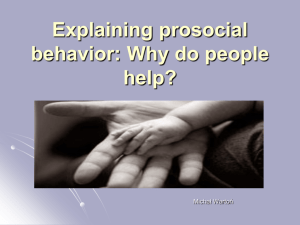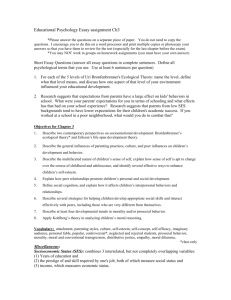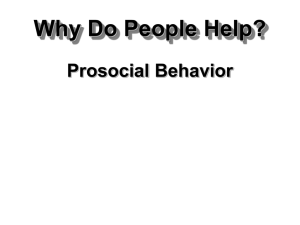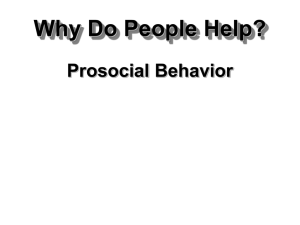Social Psychology Chapter 9
advertisement
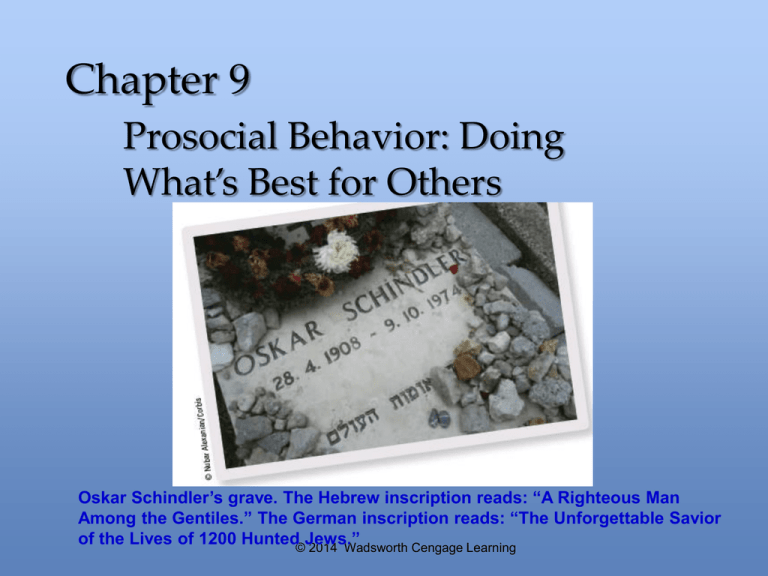
Chapter 9 Prosocial Behavior: Doing What’s Best for Others Oskar Schindler’s grave. The Hebrew inscription reads: “A Righteous Man Among the Gentiles.” The German inscription reads: “The Unforgettable Savior of the Lives of 1200 Hunted©Jews.” 2014 Wadsworth Cengage Learning What is Prosocial Behavior? Cooperation, Forgiveness, Obedience, and Conformity Why Do People Help Others? Who Helps Whom? Bystander Help in Emergencies How Can We Increase Helping? Chapter Topics http://youtu.be/qIp_8RNNX4k Consider the case of Oskar Schindler, who risked his own life and spent his life savings to rescue more than 1200 Jews from the Nazis Why do humans behave in helpful and cooperative ways even when it is not in their own self interest to do so? Debate: Help and Sacrifice Prosocial behavior: doing something good for someone or for society It builds relationships and allows society to function. Obeying rules, conforming to norms, cooperating, and helping are all forms of prosocial behavior. People behave better when others are watching and know who they are. People engage in prosocial behavior to be accepted by others. What is Prosocial Behavior? Reciprocation-the obligation to return in kind what another has done for us. Found in all cultures. Fairness- is part of culture and based on norms. Equity- means that each person receives benefits in proposition to what he or she did. Equality – means that everyone gets the same amount, regardless of performance. Factors in Prosocial Behavior How is cooperation linked to reciprocity? Prisoner’s dilemma: forced to choose between competition and cooperation How does the prisoner’s dilemma illustrate the delicate balance of cooperation? What are the most effective strategies to win in a prisoner’s dilemma game? How does communication improve cooperation? Cooperation How does forgiveness go against reciprocity? How does forgiveness benefit society? Individuals? What are some of the downsides to forgiveness? When is forgiveness more likely? Who is more likely to forgive? Forgiveness Is following orders from an authority figure. In what way is obedience prosocial? Milgram (1963) Majority of participants delivered extreme shocks to a screaming victim in obedience to an authority figure How did Milgram’s studies paint obedience? How did they influence social scientists’ views of obedience? How can obedience benefit society? How does obedience make it possible for people to live in large groups? Obedience http://youtu.be/y9l_puxcrlM Means going along with the crowd. How is conformity prosocial? In what ways is conformity beneficial? In what ways is it detrimental? How does knowing that others are watching affect our behavior? Conformity Is the strong belief in the reliability and validity of someone or something. How is trust prosocial? How does trust shape interactions? How is the Trust Game similar to the Prisoner’s Dilemma? Trust What can both of these tell us about trust? What types of people do you trust easily? What types of people do you mistrust? The evolutionary theory of kin selection suggests that we prefer to help others who are related to us. Altruistic helping Expecting nothing in return for helping Is motivated by empathy, an emotional response that corresponds to the feelings of the other person because it motivates people to reduce others’ distress. Egoistic helping Wanting something in return for helping Is helping that is motivated by the desire to reduce one’s own distress according to negative state relief theory. Why Do People Help Others? Do people ever help when they stand to gain nothing? How do positive feelings or avoidance of negative feelings offer an incentive to helpfulness? How has evolution built humans to help others? Is Altruism Possible? Mostly people get pleasure from helping others. People are more likely to help people that are similar to them. Males are more helpful than females in the overall public with strangers and emergencies. Females are more helpful with family, close relationships and in volunteering. Females are more likely to receive help than are males, regardless of whether the helper is male or female. People are more likely to help attractive individuals. People who believe the world is just will help others, but only if they think those people deserve the help. Positive mood increase helping, but some bad moods such as guilt can also promote helping. Who Helps Whom? Many people are introduced to sex partners by friends, co-workers, and relatives; however, the increase in online dating has reduced this trend Spring break sex Men will support and help each other to engage in casual sex Women will support and help each other to avoid casual sex The Social Side of Sex: Helping, Sex, and Friends The Bystander effect is the finding that people are less likely to offer help when they are in a group than when they are alone. How does the case of Kitty Genovese illustrate the bystander effect? Bystander Helping in Emergencies Helping can be increased by: Reducing uncertainties Educating others about bystander indifference Teaching moral inclusion (making others a part of the ingroup) How Can We Increase Helping? Humans help individuals and society How does prosocial behavior benefit both individuals and society? Why do humans demonstrate prosocial behavior towards those who aren’t family? What prosocial behaviors are most important to the day-to-day running of society? How do reciprocity and cooperation demonstrate the human concept of fairness? What Makes Us Human? If you donate money to charity or help a needy victim because it makes you feel good to do so, are you, in essence, being selfish and selfserving? Is altruism truly possible? Discussion: Altruism Humans engage in prosocial behavior to benefit both themselves and society Prosocial behavior is influenced by concepts of fairness, reciprocity, and cooperation Barriers to helpfulness can be overcome through education and modeling helpful behavior Conclusion
